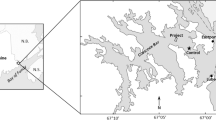Abstract
Two-current choice flumes are used to measure preference and avoidance behaviour in response to chemical cues in aquatic animals. If used correctly, they produce two parallel, non-overlapping, laminar water currents in which the animal can move freely and choose between the two currents. As climate change is affecting water temperature, and altered precipitation patterns are changing water salinity, two-current choice flumes are increasingly being used to test the choice between water currents of different temperatures and salinities. This inevitably means that water currents of different densities are being used simultaneously in the flume. Here, we investigated the tolerance range for density differences due to temperature and salinity in five common flume designs. Through dye tests and stepwise modifications of temperatures and salinities we determined the limits for laminar and non-overlapping flows. We also developed an automated method for quantifying the overlap precisely and objectively. The tolerance for density differences between the water currents where laminar and non-overlapping flows were maintained was surprisingly low, withstanding ± 0.5 °C temperature differences, and ± 0.1 PSU salinity differences, i.e. a maximum density difference of 0.28 gL−1. Above these very narrow limits we found a range where the flumes showed partly overlapping, stratified water currents that preclude easy determination of cue preference. We conclude that two-current choice flumes are not suitable for testing the behavioural choices of aquatic animals using water currents of anything other than minor differences in temperature and/or salinity.


Similar content being viewed by others
References
Abràmoff MD, Magalhães PJ, Ram SJ (2004) Image processing with image. J Biophotonics Int 11:36–41
Atema J, Kingsford MJ, Gerlach G (2002) Larval reef fish could use odour for detection, retention and orientation to reefs. Mar Ecol Prog Ser 241:151–160
Cherry DS, Cairns J (1982) Biological monitoring part V—preference and avoidance studies. Water Res 16:263–301
Diaz-Gil C, Cotgrove L, Smee SL et al (2017) Anthropogenic chemical cues can alter the swimming behaviour of juvenile stages of a temperate fish. Mar Environ Res 125:34–41
Gouraguine A, Díaz-Gil C, Reñones O et al (2017) Behavioural response to detection of chemical stimuli of predation, feeding and schooling in a temperate juvenile fish. J Exp Mar Bio Ecol 486:140–147
Herbert NA, Skjæraasen JE, Nilsen T et al (2011) The hypoxia avoidance behaviour of juvenile Atlantic cod (Gadus morhua L.) depends on the provision and pressure level of an O2 refuge. Mar Biol 158:737–746
Herbert-Read JE, Logendran D, Ward AJW (2010) Sensory ecology in a changing world: salinity alters conspecific recognition in an amphidromous fish, Pseudomugil signifer. Behav Ecol Sociobiol 64:1107–1115
James NC, Cowley PD, Whitfield AK, Kaiser H (2008) Choice chamber experiments to test the attraction of postflexion Rhabdosargus holubi larvae to water of estuarine and riverine origin. Estuar Coast Shelf Sci 77:143–149
Jutfelt F, Hedgärde M (2013) Atlantic cod actively avoid CO2 and predator odour, even after long-term CO2 exposure. Front Zool 10:81–89
Jutfelt F, Sundin J, Raby GD et al (2017) Two-current choice flumes for testing avoidance and preference in aquatic animals. Methods Ecol Evol 8:379–390
Kelley D, Richards C (2017) “oce”: analysis of oceanographic data. R package version 0.9-18. http://cran.rproject.org/package=oce
Leduc AOHC, Ferrari MCO, Kelly JM, Brown GE (2004) Learning to recognize novel predators under weakly acidic conditions: the effects of reduced pH on acquired predator recognition by juvenile rainbow trout. Chemoecology 14:107–112
Morais P, Parra MP, Baptista V, Ribeiro L (2017) Response of Gilthead Seabream (Sparus aurata L., 1758) larvae to nursery odor cues as described by a new set of behavioral indexes. Front Mar Sci 4:1–13
Myrick CA, Folgner DK, Cech JJ (2004) An annular chamber for aquatic animal preference studies. Trans Am Fish Soc 133:427–433
Netter KJ (1985) Fundamentals of aquatic toxicology—methods and applications. Hemisphere Publishing Corporation, New York
Pecl GT, Araújo MB, Bell JD et al (2017) Biodiversity redistribution under climate change: Impacts on ecosystems and human well-being. Science 80:355
Pistevos JCA, Nagelkerken I, Rossi T, Connell SD (2017) Ocean acidification alters temperature and salinity preferences in larval fish. Oecologia 183:545–553
Poletto JB, Cocherell DE, Klimley AP et al (2013) Behavioural salinity preferences of juvenile green sturgeon Acipenser medirostris acclimated to fresh water and full-strength salt water. J Fish Biol 82:671–685
R Core Team (2017) R: a language and environment for statistical computing. R Found Stat Comput
Serrano X, Grosell M, Serafy JE (2010) Salinity selection and preference of the grey snapper Lutjanus griseus: field and laboratory observations. J Fish Biol 76:1592–1608
Sundin J, Jutfelt F (2016) 9–28 days of exposure to elevated pCO2 reduces avoidance of predator odour but had no effect on behavioural lateralization or swimming activity in a temperate wrasse (Ctenolabrus rupestris). ICES J Mar Sci 73:620–632
Winberg S, Olsén KH (1992) The influence of rearing conditions on the sibling odour preference of juvenile arctic charr, Salvelinus alpinus L. Anim Behav 44:157–164
Acknowledgements
We would like to express our gratitude to the Laboratori d’Investigacions Marines i Aqüicultura, LIMIA (Balearic Government), member of the joint research unit IMEDEA-LIMIA, for the use of the facilities and its staff for the kind support provided throughout. We would also like to thank Heather Baxter for her help with running some of the experiments at LIMIA and Rocío Santiago Doménech for conducting the salinity measurement validation. This work was funded by the Swedish Research Council Formas (JS: 2013-947, FJ: 2009-596) and The Research Council of Norway (FJ: 262942).
Author information
Authors and Affiliations
Contributions
AG, FJ, JS, CDG and JM conceived the idea. AG, JM, FJ, JS conducted the laboratory experiments. CDG and AG analysed the data and created figures and tables. AG, FJ and JS wrote the manuscript. JM and CDG revised the manuscript.
Corresponding author
Additional information
Communicated by Joel Trexler.
Electronic supplementary material
Below is the link to the electronic supplementary material.
Rights and permissions
About this article
Cite this article
Gouraguine, A., Díaz-Gil, C., Sundin, J. et al. Density differences between water masses preclude laminar flow in two-current choice flumes. Oecologia 189, 875–881 (2019). https://doi.org/10.1007/s00442-019-04363-7
Received:
Accepted:
Published:
Issue Date:
DOI: https://doi.org/10.1007/s00442-019-04363-7




